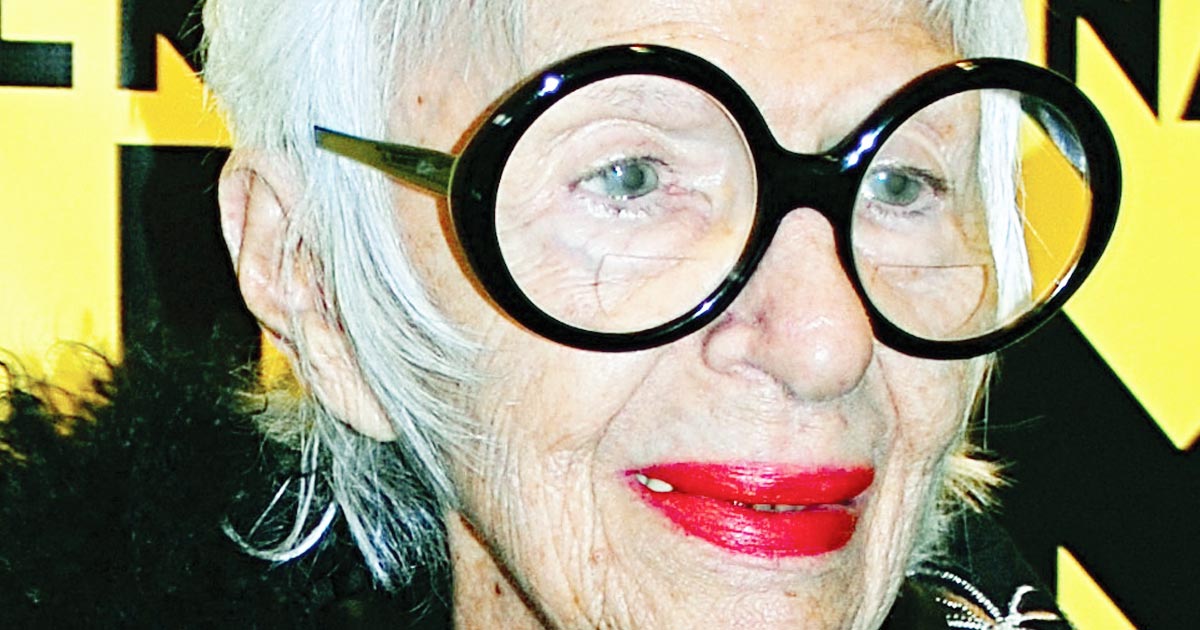This article contains affiliate links.
By CARRIE SCOZZARO
Rare bird. Fashion Icon. Geriatric starlet.
At almost 102—her birthday is August 29—Iris Apfel has acquired a lot of nicknames, including a few she’s given herself.
First Lady of Fabric
“First lady of fabric” came from Apfel’s decades of working in textiles, over a succession of presidents from Truman through Clinton.
“One of America’s quintessential stylemakers” is what the venerable Metropolitan Museum of Art called Apfel when its Costume Institute showcased a tiny portion of her considerable costume jewelry and clothing collection. Included in the 2005 exhibition were Apfel’s trademark oversized glasses and outfits highlighting Apfel’s signature style: a surprisingly cohesive cacophony of competing patterns, textures, and colors.
Titled “Rara Avis (Rare Bird),” the Apfel exhibition marked the first time the Institute featured a non-designer, elevating Apfel to the heights of such internationally celebrated fashion mavericks as Coco Chanel, Prada, and Alexander McQueen.
World’s Oldest Living Teen
“World’s oldest living teenager” is what Apfel called herself in a 2019 interview about representing Magnum ice cream for an advertising campaign, titled Never Stop Playing. Aged 97 at the time, it was the same year Apfel signed an international modeling contract and just a year after being immortalized in the form of a Barbie doll.
Geriatric Starlet
“Geriatric starlet” is another of Apfel’s nicknames for herself. She incorporated the moniker into her second book, Iris Apfel: Accidental Icon—Musings of a Geriatric Starlet.
Personal History
Apfel never set out to be an icon.
Born to Iris Barrel in Queens, New York, Apfel credits her family with sparking her curiosity about fabric and especially patterns, two of the things for which Apfel is known. Apfel’s mother owned a fashion boutique, and her grandmother let her play with fabric scraps.
In several interviews, Apfel describes how she was also influenced by early explorations of Manhattan’s vibrant and diverse cultural landscape, including a thriving vintage and clothing scene.
Apfel stayed close to home to study art history at New York University, then headed west to attend art school at the University of Wisconsin. After college, Apfel hired on as a copywriter for Women’s Wear Daily, when it was being transformed from a textile industry trade publication to a burgeoning fashion magazine.
In 1948, Apfel married the love of her life, Carl Apfel, a textile merchant (he died in 2015, a year after the release of Apfel’s self-titled documentary, Iris).
Together the couple created Old World Weavers in 1950, which specialized in created historical reproductions of mostly 17th, 18th, and 19th century European patterns. They worked out of a Manhattan showroom, but traveled the world over, which allowed Apfel to shop for clothes in both vintage shops and high-end fashion venues, as well as hunt for costume jewelry, unusual décor, and unique textiles.
Growing Fame
In the Venn diagram of Apfel’s life, textiles overlapped with fashion and interior design, all of which she pursued with relative anonymity outside her native New York City, until the Metropolitan exhibition in 2005. From there, Apfel’s fame and fortune grew and grew.
One thing that has not grown, however, is Apfel’s ego.
In an interview for the 2018 book release, Apfel described why, despite her enviable success, she didn’t want to write a memoir, nor create a “how-to” book.
“I find how-to books rather insulting. It’s not my place to tell you how to dress or what to do. I think it should be an individual matter,” she was quoted as saying.
Instead, the book features random “musings” her all-ages audience might appreciate, including her 1,065,059 (and counting) Facebook followers (facebook.com/IrisApfelofficial) and her more than two million Instagram followers (#irisapfel).
Both sites give a good sense of Apfel’s fan base, who are shown sharing photos of their kids, dogs, or themselves dressed like Apfel; of the artwork fans make about Apfel; and of projects inspired by the centenarian.
And the last chapter in the book? “How to Live to be 200.” ISI









